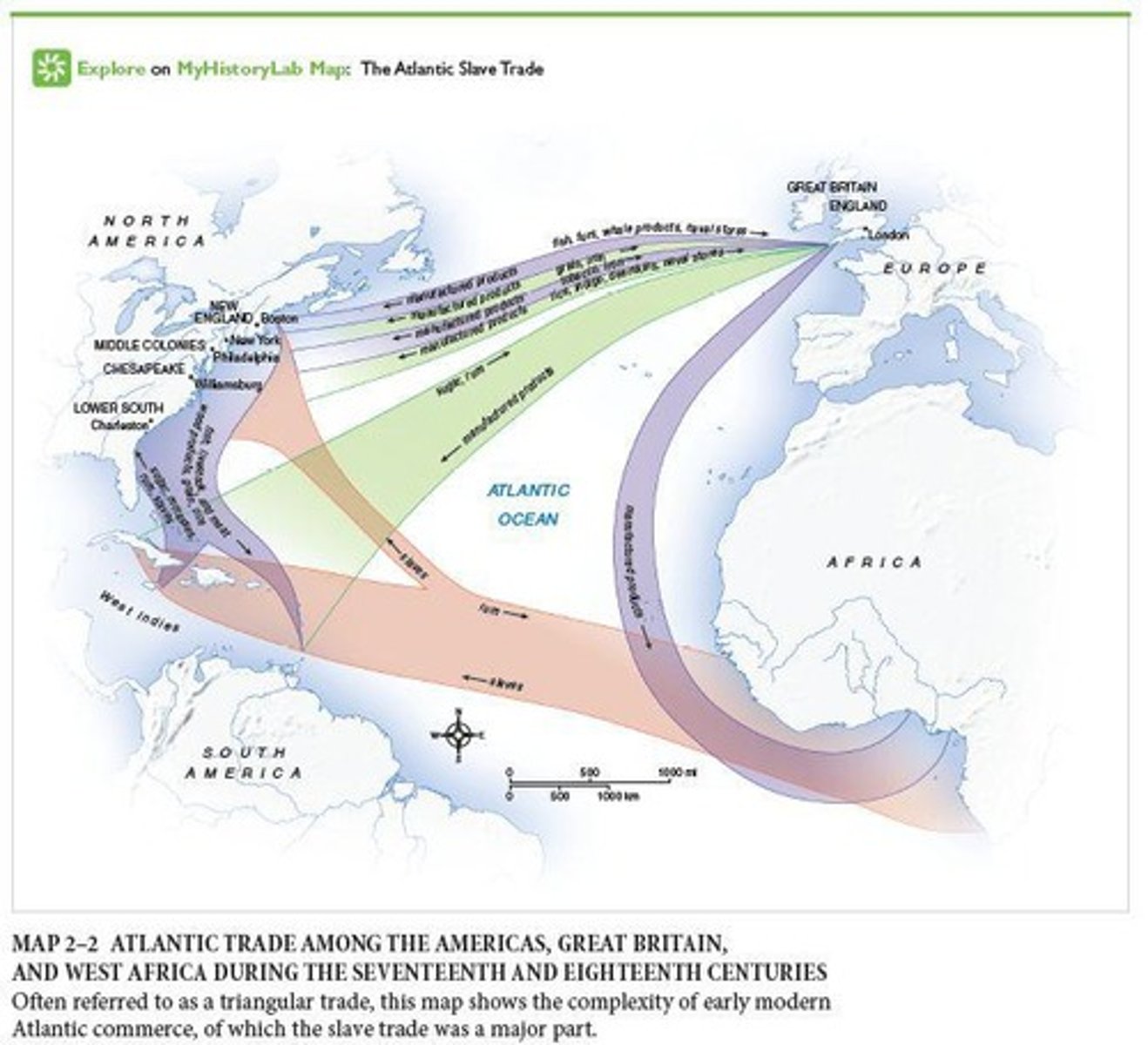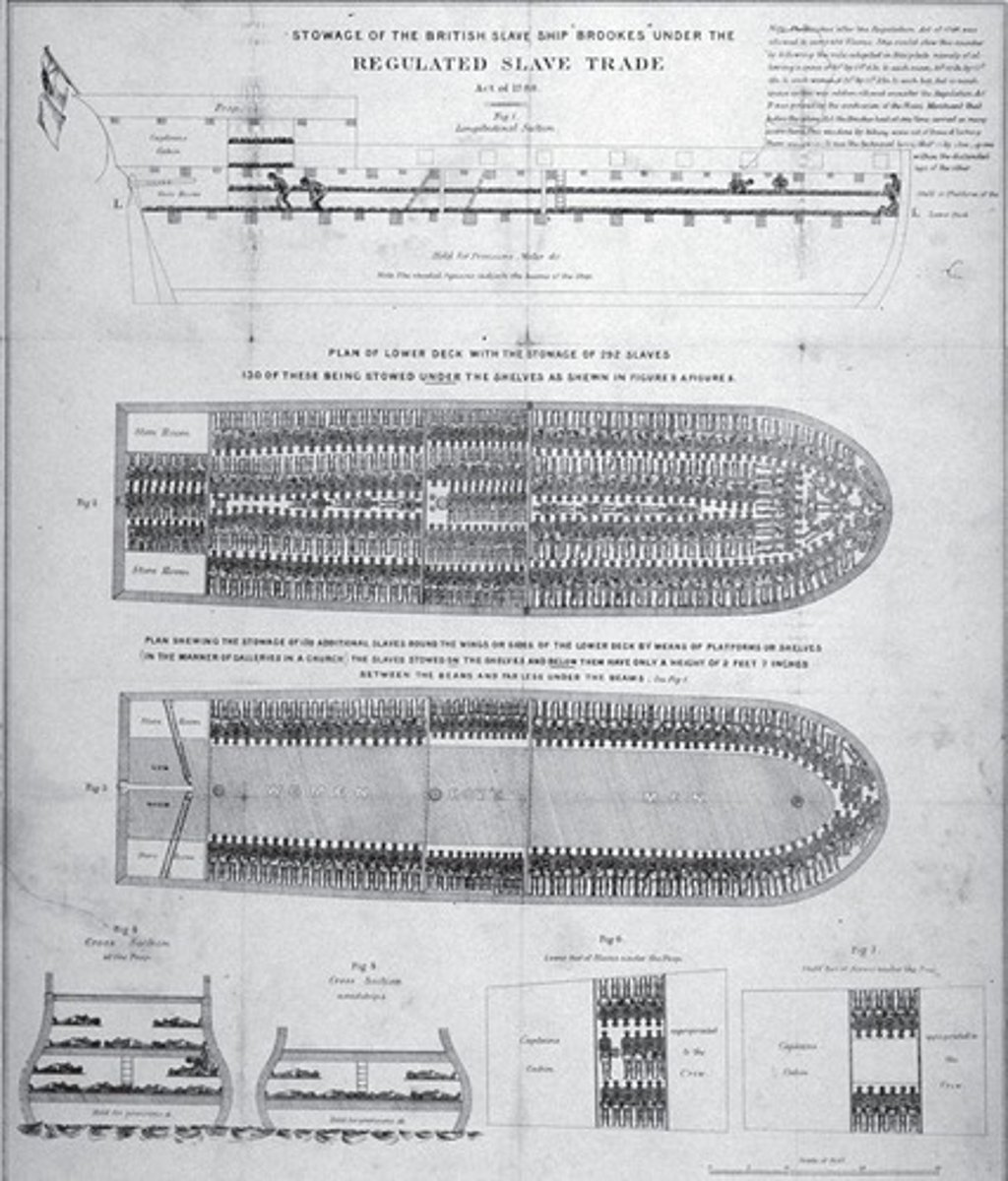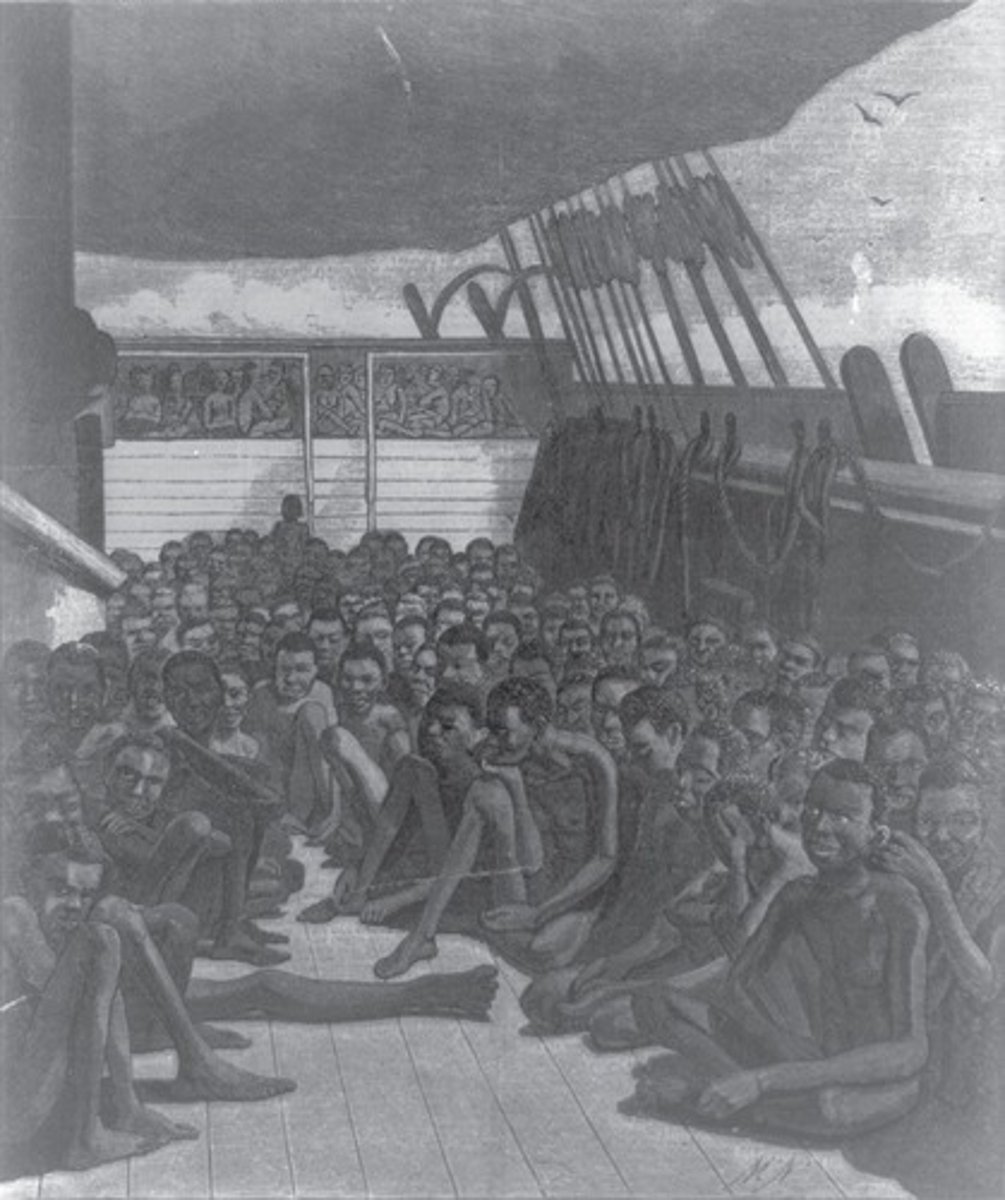The Atlantic Slave Trade: Middle Passage, Impact, and End
1/94
There's no tags or description
Looks like no tags are added yet.
Name | Mastery | Learn | Test | Matching | Spaced |
|---|
No study sessions yet.
95 Terms
Middle Passage
The voyage of slave ships (slavers) across the Atlantic Ocean from Africa to the Americas.
Seasoning
The process through which newly arrived enslaved Africans were acclimatized to the conditions in the Americas.
Atlantic Slave Trade
The trade system that involved the transportation of enslaved Africans to the Americas.

Trans-Sahara Slave Trade
A trade system that made West African cities wealthy, dealing mainly in men who were in high demand as field workers.
Islamic Slave Trade
A slave trade conducted by Sudanese that included both blacks and whites, mainly involving women and children.
European Age of Exploration
A period when European nations sought to colonize Africa and establish trade routes.
Portuguese Interest in Africa
During the fifteenth century, the Portuguese were primarily interested in Africa as a source of slaves for Europe.
Spanish Interest in Africa
During the fifteenth century, the Spanish were primarily interested in Africa as a source of slaves for Europe.
Impact of Diseases on Indigenous Americans
Indigenous Americans died of diseases or fled due to the arrival of Europeans.
Workforce Demand
The demand for labor that caused the Atlantic slave trade to flourish.
H.M.S. Undine
A British warship that enforced the ban on the Atlantic slave trade and rescued people from a slave ship.

Fifteenth Century Trade Importance
Africa was more important as a source of trade and wealth than Asia during the fifteenth century.
Slavery Existence
Slavery existed in all cultures for thousands of years.
African Adaptation
Africans adapted to conditions in the Americas after crossing the Atlantic.
Treatment of Slaves in the Americas
The conditions and treatment that enslaved individuals faced in the Americas.
End of the Atlantic Slave Trade
The factors that led to the conclusion of the Atlantic slave trade.
European Colonization Goals
European nations sought to colonize Africa for trade and to convert populations to Christianity.
Demand for Slaves
The high demand for slaves in Europe that fueled the Atlantic slave trade.
Indigenous American Enslavement
Columbus enslaved indigenous Americans after accidentally landing in the Americas.
Woodcut Illustration
An early nineteenth-century woodcut depicting the rescue of individuals from a slave ship.
African Forest Dwellers
A group involved in the slave trade in Africa, as noted by Europeans upon their arrival.
Berbers from North Africa
A group involved in the slave trade in Africa, as noted by Europeans upon their arrival.
Guinea Coast
The southward-facing coast of West Africa, from which many people caught up in the Atlantic slave trade departed for the Americas.
Chattel
A form of slavery in which the enslaved are treated legally as property.
Asiento
The monopoly over the slave trade from Africa to Spain's American colonies.
Cash crop
A crop grown for sale rather than subsistence.
Industrial Revolution
An economic change that began in England during the early eighteenth century, where industry became the dominant form of enterprise.
Bartolomeo Dias
A historical figure whose voyages drastically changed the slave trade.
Vasco da Gama
A historical figure whose voyages drastically changed the slave trade.
Christopher Columbus
A historical figure whose voyages drastically changed the slave trade.
Antam Goncalvez
A historical figure whose voyages drastically changed the slave trade.
Indigo
A bluish-violet dye produced from the indigo plant.
Sugar cultivation
An extremely profitable agricultural practice in the Americas that increased the demand for slave labor.
Slave trade profits
Financial gains from the slave trade that helped fund the Industrial Revolution.
Tobacco
A crop that increased the demand for slaves during the Atlantic slave trade.
Interethnic warfare
Conflict among different ethnic groups that produced slaves for trade.
Racial solidarity
The lack of unity among Europeans and Africans during the slave trade.
European reliance
The dependence of Europeans on the Atlantic slave trade due to the decline of American Indian populations.
Sixteenth century labor demand
The enormous demand for labor produced by gold and silver mines and sugar plantations in Latin America.
Dominance of Spain and Portugal
The control exerted by Spain and Portugal over the Atlantic slave trade.
Most slaves
The demographic of the enslaved population, which was predominantly men or boys.
Factories
Headquarters for a European company that traded for slaves or engaged in other commercial enterprises on the West African coast.
The Crossing
The forced journey of captives from their native land to the Americas, lasting three to six months.
Slavers
Ships used to transport slaves from Africa to the Americas.

Mortality Rate
High death rate among slaves due to seaboard epidemics during transport.
Bondage Hardware
Equipment included on slavers designed to restrain slaves during transport.
Olaudah Equiano
An African captured and sent to the West Indies, who documented his experiences.
Voyages
Journeys that lasted three to six months, often delayed by human and natural causes.
European Brutalization
The systematic destruction of self-respect and identity among captured Africans.
Tight Packed
A method of loading slaves onto ships where they were chained together to maximize space.
Hurricanes and Doldrums
Natural causes that could delay slave voyages across the Atlantic.
Desperation of Slaves
Some slaves preferred drowning to enduring the conditions aboard the slavers.
Crews' Control
Slavers forced captives to sing and dance as a means of control during the voyage.
Industrial Revolution Delay
The profits from the Atlantic slave trade delayed the Industrial Revolution by at least a century.
Improvement of Conditions
The profits from the slave trade contributed to the improvement of conditions on slavers.
Slavers as Useful Machines
By the eighteenth century, slavers were built to resist storms and better ventilated.
Branded Like Cattle
Captives were marked to signify ownership, similar to livestock.
Engraving of Slave Traders
A depiction of African slave traders conducting bound captives toward European trading posts.
John Newton
Indentured servant who became a crew member and then captain of a slaver, purchased West African slaves, sailed to the West Indies, and after retirement, repented his involvement in the slave trade.
Indentured servant
A person who sold his or her freedom to a master for a term of years.
Provisions for the Middle Passage
Slave captains purchased African staples for slaves but skimped on supplies to save money, leading to many deaths from malnutrition and refusal to eat.
Sanitation, Disease, and Death
Death rates were astronomical on slave ships due to diseases like dysentery and smallpox, which killed most slaves.
Ship surgeons
Rewarded for delivering healthy slaves, often disregarding African remedies as superstitions.
Resistance and Revolt at Sea
Africans often rebelled against bondage, and failed slave mutineers could expect harsh punishment.
Cruelty
Debate among scholars about how much cruelty enslaved Africans suffered, with the primary cause of death being uncertain.
African Women on Slave Ships
Women were worth half the price of men and were often sexually abused by crew members.
Epidemic disease
Identified as one of the primary causes of death at sea during the Middle Passage.
Starvation
Another primary cause of death at sea during the Middle Passage.
Overcrowding
A condition that contributed to the high mortality rates during the Middle Passage.
Harsh treatment and beatings
A factor that led to deaths at sea during the Middle Passage.
Slave rebellions and mutinies
Rare events during the Middle Passage, leading slaver crews to generally feel safe.
Landing and Sale in the West Indies
Crew prepared human cargo for sale, where slaves suffered close inspection at market.
Martinique
An island in the eastern Caribbean Sea that was a French sugar-producing colony from the seventeenth into the nineteenth centuries.
Barbados
An island nation in the Lesser Antilles, located to the southeast of Puerto Rico.
Physical inspections
The humiliating process Africans endured before being sold in the market.
Preparation for landing
Slaver captains cleaned, exercised, and rested slaves in preparation for landing in the West Indies.
Creoles
Persons of African or European parentage born in the Americas.
Acculturated
Change in individuals who are introduced to a new culture.
Slave ship owners
Sold their cargo at the first port of call in order to return to Africa as soon as possible to pick up another cargo.
Weak or unhealthy slaves
Thrown overboard by slaver captains in preparation for landing in the West Indies.
Disciplinary process
To make slaves effective laborers.
New Africans
Provided labor for slave lands and learned building and agriculture skills.
Survival criteria
Adaptation to new foods, climate, and language for successfully seasoning new slaves.
Bonds with shipmates
Created by slaves similar to family relationships when their ties to their villages and families were broken.
English abolitionists
Crusaded against slavery as the industrialized economy became less dependent on the slave trade.
Guinea, West Africa
Fought to keep the slave trade going as their economies depended on it.
Adaptation to new foods
One of the primary criteria for successfully seasoning new slaves.
Surplus crops
Slaves saved for future use.
Planters' preference
Preferred new arrivals from Africa, women and children, and those from the coastal regions of West Africa.
Creole dialects
Africanized versions of French and English produced by slave society.
Industrializing economy
In the early 1800s, it was less dependent on the slave trade.
Growing number of English abolitionists
Had little effect on the slave trade at the end of the 1700s.
11 million Africans
Brought to the Americas over three centuries of slavery.
40 million Americans
Of African descent are alive today.
Reasons for decline of slave trade
Thrive for over three hundred years, then declined and ended in about fifty years.